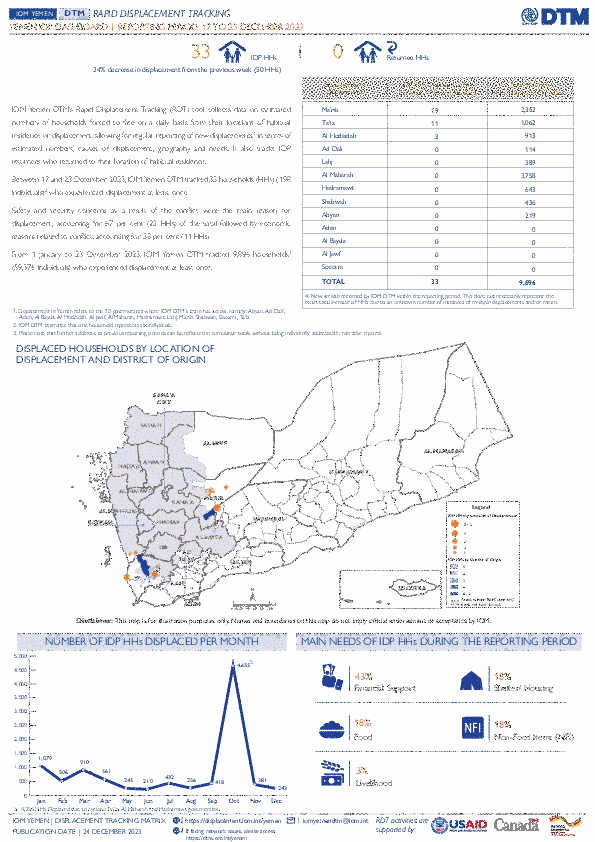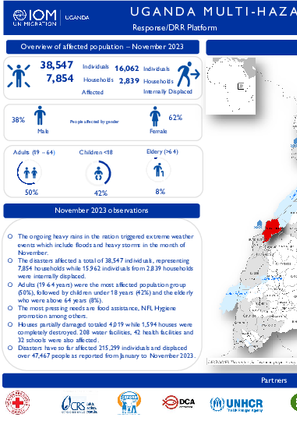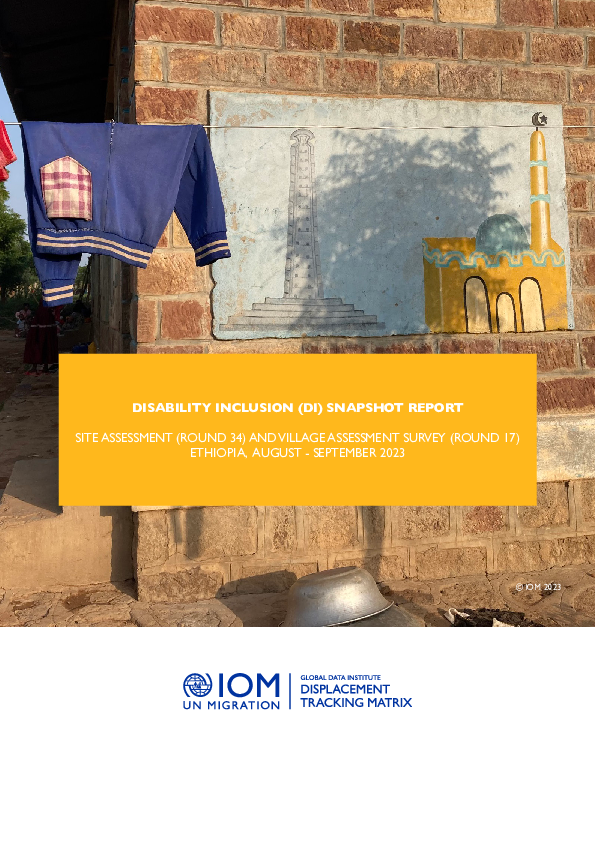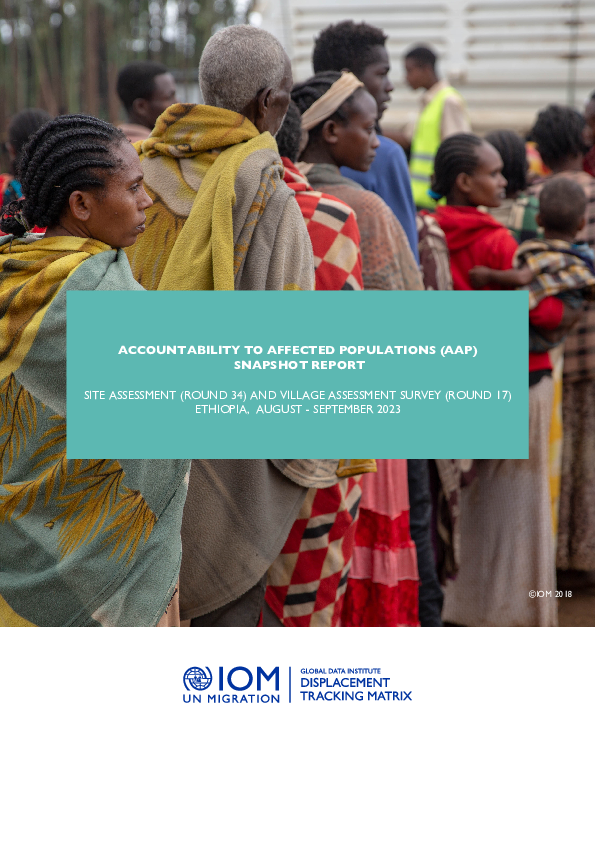-
Countries
-
Data and Analysis
-
Special Focus
-
Crisis Responses
Contact
DTM Yemen, iomyemendtm@iom.int
Location
Yemen
Activity
- Mobility Tracking
- Event Tracking
Period Covered
Dec 17 2023 -Dec 23 2023
From 1 January to 23 December 2023, IOM Yemen DTM tracked 9,896 households (HH) (59,376 Individuals) who experienced displacement at least once.
Between 17 and 23 December 2023, IOM Yemen DTM tracked 33 households (198 individuals) displaced at least once. The majority of people moved into/within the following governorates and districts:
- Ma’rib (19 HHs) – Marib City (9 HHs), Harib (5 HHs), Marib (5 HHs) districts. Most displacements in the governorate originated from Marib and Hajjah.
- Ta’iz (11 HHs) – Al Maafer (4 HHs), Al Makha (4 HHs), Salah (2 HHs) districts. Most displacements in the governorate originated from Taiz and Al Hodeidah.
- Al Hodeidah (3 HHs) – Hays (2 HHs), Al Khukhah (1 HHs) districts. Most displacements in the governorate originated from Taiz and Al Hodeidah.
The majority of people moved from the following governorates and districts:
- Ta’iz (13 HHs) – Maqbanah (6 HHs), Al Maafer (3 HHs), Jabal Habashi (2 HHs) districts.
- Ma’rib (7 HHs) – Harib (5 HHs), Majzar (1 HHs), Raghwan (1 HHs) districts.
- Al Hodeidah (4 HHs) – Al Marawiah (1 HHs), At Tuhayta (1 HHs), Al Mina (1 HHs) districts.
Population Groups
Survey Methodology
Unit of Analysis Or Observation
Type of Survey or Assessment
Keywords
Geographical Scope
Administrative boundaries with available data
The current dataset covers the following administrative boundaries

Contact
DTM Yemen, iomyemendtm@iom.int
Language
English
Location
Yemen
Period Covered
Dec 17 2023
Dec 23 2023
Activity
- Mobility Tracking
- Event Tracking
IOM Yemen DTM’s Rapid Displacement Tracking (RDT) tool collects data on estimated numbers of households forced to flee on a daily basis from their locations of origin or displacement, allowing for regular reporting of new displacements in terms of estimated numbers, geography, and needs. It also tracks returnees who returned to their location of origin.
From 1 January to 23 December 2023, IOM Yemen DTM tracked 9,896 households (HH) (59,376 Individuals) who experienced displacement at least once.
Between 17 and 23 December 2023, IOM Yemen DTM tracked 33 households (198 individuals) displaced at least once. The majority of people moved into/within the following governorates and districts:
- Ma’rib (19 HHs) – Marib City (9 HHs), Harib (5 HHs), Marib (5 HHs) districts. Most displacements in the governorate originated from Marib and Hajjah.
- Ta’iz (11 HHs) – Al Maafer (4 HHs), Al Makha (4 HHs), Salah (2 HHs) districts. Most displacements in the governorate originated from Taiz and Al Hodeidah.
- Al Hodeidah (3 HHs) – Hays (2 HHs), Al Khukhah (1 HHs) districts. Most displacements in the governorate originated from Taiz and Al Hodeidah.
The majority of people moved from the following governorates and districts:
- Ta’iz (13 HHs) – Maqbanah (6 HHs), Al Maafer (3 HHs), Jabal Habashi (2 HHs) districts.
- Ma’rib (7 HHs) – Harib (5 HHs), Majzar (1 HHs), Raghwan (1 HHs) districts.
- Al Hodeidah (4 HHs) – Al Marawiah (1 HHs), At Tuhayta (1 HHs), Al Mina (1 HHs) districts.
IOM identified 27 households displaced in the previous reporting period, which covered 10 - 16 December 2023, in the governorates of Ma’rib (22 HHs), Ta’iz (3 HHs), and Al Hodeidah (2 HHs). These figures have been added to the cumulative displacement total recorded since the beginning of the year.

Contact
DTM Pakistan, iomisbdtmremapteam@iom.int
Language
English
Location
Pakistan
Period Covered
Dec 01 2023
Dec 15 2023
Activity
- Flow Monitoring
• During this reporting period, returns of Afghans have remained high, however, DTM teams have observed a decrease of 51 per cent in returns as compared to the last two weeks of November.
• Eighty-seven per cent of the annual returns in 2023 have occurred since the announcement of the IFRP on 15 September 2023.
• In terms of push factors, during the current reporting period, 82 per cent of the surveyed returnee families indicated they
are moving back to Afghanistan due to fear of arrest. Thirty-one per cent also indicated forced repatriation as an important push factor.
• During the reporting period, three per cent of the overall flow could be considered vulnerable persons. The Displacement Tracking Matrix (DTM) registered 414 returnees moving back to Afghanistan who were chronically ill and require medical attention, in addition to 263 elderly individuals, and 96 persons with disabilities (PWD).

Contact
DTM DRC, iomdrcdtm@iom.int
Language
English
Location
Democratic Republic of the Congo
Period Covered
Nov 20 2023
Dec 15 2023
Activity
- Event Tracking
Since the beginning of the crisis, IOM, through its Displacement Tracking Matrix (DTM) continues to conduct a series of rapid assessments, including emergency monitoring (EET/ERM), crisis analysis and registration with a priority to respond to immediate information needs with a view to understanding displacement dynamics and needs. This report presents the results of assessments carried out in the various displacement and return areas from 20 November to 15 December 2023.
The displacement data collected in this eleventh crisis analysis shows a further increase in the number of displaced people compared with the previous publication. The total number of IDPs rose from 1,076,261 to 1,240,215 as of 15 December 2023. DTM estimates the total number of newly displaced individuals by the upsurge in conflict at the beginning of December at 163,954. This increase is due to multiple clashes between government and M23 forces, in particular those which have taken place in the territories of Masisi and Nyiragongo, seeing the extension of the M23 group's area of control.

Contact
DTM DRC, iomdrcdtm@iom.int
Language
French
Location
Democratic Republic of the Congo
Period Covered
Nov 20 2023
Dec 15 2023
Activity
- Event Tracking
Depuis le début de la crise, l'OIM, par le biais de la DTM continue à mener une série d'évaluations rapides, y compris le suivi des urgences (EET/ERM), l'analyse des crises et enregistrement avec priorité de répondre aux besoins immédiats d'information en vue de comprendre la dynamique des déplacements et les besoins. Ce rapport présente les résultats des évaluations menées dans les différentes zones de déplacement et de retour du 20 novembre au 15 décembre 2023.
Les données sur les déplacements recueillies dans cette onzième analyse de crise montrent une nouvelle augmentation du nombre de personnes déplacées par rapport à la publication précédente (voir le rapport). Le nombre de personnes déplacées est passé de 1 076 261 à 1 240 215 personnes au 15 décembre 2023. Cette augmentation de 15 pour cent est due aux multiples attaques, notamment celles qui ont touché les territoires de Masisi et Nyiragongo, qui ont vu l'extension des zones de contrôle du groupe M23.

Contact
DTM Uganda, dtmuganda@iom.int
Language
English
Location
Uganda
Period Covered
Nov 01 2023
Nov 30 2023
Activity
- Mobility Tracking
The ongoing heavy rains in the nation triggered extreme weather events which include floods and heavy storms in the month of November.
o The disasters affected a total of 38,547 individuals, representing 7,854 households while 15,962 individuals from 2,839 households were internally displaced.
o Adults (19-64 years) were the most affected population group (50%), followed by children under 18 years (42%) and the elderly who were above 64 years (8%).
o The most pressing needs are food assistance, NFI, Hygiene promotion among others.
o Houses partially damaged totaled 4,019 while 1,594 houses were completely destroyed. 208 water facilities, 42 health facilities and 32 schools were also affected.
o Disasters have so far affected 215,299 individuals and displaced over 47,467 people as reported from January to November 2023.

Contact
IOMDTMPoland@iom.int
Language
English
Location
Poland
Period Covered
Sep 01 2023
Nov 30 2023
Activity
- Survey
In March of 2023, IOM Poland launched its Integration Survey to assess the progress and needs relating to labour and social integration of refugees from Ukraine in Poland.
The aim of the assessment is to gain an understanding of the employment situations, housing needs, financial resilience, social cohesion, barriers to accessing services, and short-medium term needs of refugees. In the 1 September - 30 November 2023 period, a total of 1,232 surveys were conducted.
This report provides a snapshot of the social integration of Ukrainian refugees in Poland for the period of September through November of 2023, as well as an overview of key trends based on data collected from March 2023 through November (page 2).
Key Findings
- The length of time spent in Poland is a significant determinant of the level of social integration of respondents. Those who had lived in Poland for more than 12 months at the time of interview had a higher average social integration score* (0.32) compared to those who had lived in Poland for less than 12 months (0. 23).
- The level of social integration reduced consistently as the age of respondents increased, with those 18–24 years old having a much higher average score (0.40), and those over 65 having a lower average score (0.24).
- Students, business owners, and those employed full-time had the highest levels of social integration (>0.39), as compared to those who were retired, unemployed, or carried out family responsibilities, who had the lowest scores (<0.22).

Contact
DTM Ethiopia, DTMEthiopia@iom.int
Language
English
Location
Ethiopia
Period Covered
Aug 01 2023
Sep 02 2023
Activity
- Mobility Tracking
- Site Assessment
- Village Assessment
Between August and September 2023, the International Organization for Migration (IOM), through its Displacement Tracking Matrix (DTM) methodology, deployed the Site Assessment (SA) Round 34 and Village Assessment Survey (VAS) Round 17 assessment tools to assess the mobility, needs and vulnerabilities of Internally Displaced Persons (IDPs) and returning IDPs across Ethiopia.
This snapshot report will present key findings on needs and vulnerabilities, and will focus on obstacles related to accessing shelter/Non-Food Items (ESNFI) and Water, Sanitation and Hygiene (WASH) in the locations assessed through the SA and VAS assessments. The indicators included in the assessments were designed by the Disability Inclusion (DI) expert in country with support from the IOM-DTM team, and aim to shed light on the obstacles that people with difficulties seeing, hearing, walking, communicating and understanding, face in relation to their shelters, accessing distributions and using bathing facilities/latrines. In 61.67% of sites with IDPs, the first obstacle in relation to shelter was physical barriers to enter and leave their home and circulate inside the shelter.

Contact
DTM Ethiopia, DTMEthiopia@iom.int
Language
English
Location
Ethiopia
Period Covered
Aug 01 2023
Sep 02 2023
Activity
- Mobility Tracking
- Site Assessment
- Village Assessment
Between August and September 2023, the International Organization for Migration (IOM), through its Displacement Tracking Matrix (DTM) methodology, deployed the Site Assessment (SA) Round 34 and Village Assessment Survey (VAS) Round 17 assessment tools to assess the mobility, needs and vulnerabilities of Internally Displaced Persons (IDPs) and returning IDPs across Ethiopia.
As part of its commitment to Accountability to Affected Populations (AAP) principles, IOM Ethiopia’s AAP and DTM teams have closely worked together on AAP implementation and mainstreaming in DTM operations. The DTM team reviewed and incorporated indicators related to AAP within the SA and VAS tools, to map communities’ access to feedback mechanisms and involvement in the decision-making process surrounding humanitarian aid. The indicators were included in the August - September 2023 multisectoral assessments which took place nationwide in IDP sites (SA) and villages of return (VAS).
The key findings from the assessments are presented in this snapshot report. Group discussions with IDPs (for SA) and with returning IDPs (for VAS) were asked if members of the target population in the location were aware of mechanisms to provide feedback and make complaints about the quality, quantity and appropriateness of the humanitarian aid they receive. In 59.20% of sites no IDPs in the location were aware of these mechanisms and in 52.56% of villages no returning IDPs were aware.
The current El Niño conditions and the positive Indian Ocean Dipole have brought increased rains in most parts of the East and Horn of Africa, causing riverine and flash floods. The most affected countries have been Somalia (1.7 M), Ethiopia (763 K) and Kenya (475 K), with almost 3 million people affected and over 1.5 million displaced in those countries. Torrential rains also affected critical infrastructure, such as roads, bridges, water sources, and health facilities. This is seriously straining the operational capacity of humanitarian actors to support those most in need. Although the above-average rainfall may help pastoralist communities recover from the 2020–2023 drought, there are also risks of pasture and livestock disease outbreaks that may trigger food insecurity and waterborne diseases. According to the World Meteorological Organization, El Niño conditions are forecast to continue through at least April 2024, while the positive Indian Ocean Dipole is expected to last until February 2024.

